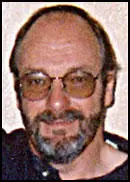Allan Eaglesham

Allan Eaglesham was born in Rutherglen, near Glasgow, Scotland in 1945. He attended Bankhead School, Rutherglen Academy, the University of Glasgow, and the University of Bristol and has a PhD in plant physiology and biochemistry. He did postgraduate work at the University of Warwick and Rothamsted Experimental Station before moving to the United States to take a job at the Boyce Thompson Institute. Allan Eaglesham is now self-employed as a consultant and free-lance editor.
Allan Eaglesham has been interested in the assassination of John F. Kennedy since it happened, but particularly since 1993. He has published articles on general aspects of the assassination, on the "sniper's nest," and on the ancillary case of the death of US Navy Lieutenant Commander William B. Pitzer. He also manages the website of the research journal JFK/Deep Politics Quarterly.
Primary Sources
(1) Allan Eaglesham and R. Robin Palmer, The Untimely Death of Lieutenant Commander William B. Pitzer (January 1998)
The Pitzers rose a little earlier than usual that fall Saturday morning, 29 October 1966. Bill fixed breakfast while Joyce made preparations in anticipation of a visit from her mother for a few days. Late morning saw them raking leaves in the yard as their 14-year-old son Robert washed the car. When, around noon, a neighbor dropped by to invite the boy to join her in a couple of rounds of golf, Bill finished polishing the automobile. After lunch, he dropped Joyce off at the beauty salon for a 1.00 PM appointment, drove over to the golf course to remind Robert to have a haircut, then stopped in at work to prepare a lecture he was to deliver at Montgomery Junior College the following Wednesday. Joyce missed the 3:07 PM bus, but caught it at 4:07 PM, and was surprised that Bill was not already home when she arrived there. She called his office, and, getting no reply, assumed that he was on his way. As time passed, feeling increasingly uneasy, she called the office again, and again, his club and the hospital emergency room. At 7:20 PM, she called the main switchboard at Bill’s place of work: the National Naval Medical Center (NNMC), Bethesda, Maryland. The duty officer was alerted. Ensign J.M. Quarles and Security Patrol Officer T.E. Blue opened the locked door to Pitzer’s television-studio office at 7:50 PM, and found a body on the floor, the head resting in a pool of coagulated blood, a revolver lying close by. Death was pronounced by Medical Officer Lieutenant Commander R.W. Steyn at 8:10 PM, and identification was made by Captain J.H. Stover and Lt. Cdr. J.G. Harmeling; the corpse was that of Lt. Cmdr. William B. Pitzer of the US Navy Medical Service Corps.
(2) Allan Eaglesham, Interpretations of New Evidence in the Pitzer Case (April 1998)
Pitzer's untimely passing (on 29 October 1966, at Bethesda Naval Hospital) is one of some forty that constitute the "mysterious deaths" of people directly or indirectly associated with the assassination of President Kennedy. In their book JFK; The Dead Witnesses (1995, Consolidated Press International, Tulsa, pp. 40-41), John Armstrong and Craig Roberts described Pitzer's demise as "one of the strangest cases of 'suicide' in the history of the Kennedy assassination." Pitzer is linked to the JFK assassination via Dennis David, a friend, naval colleague and protégé of Pitzer's, who maintains that he saw in his mentor's possession black and white photographs, color slides and, most significantly, movie film exposed during President Kennedy's autopsy, within a few days of the assassination. Therefore, if, as the recently released evidence suggests, William Pitzer did not commit suicide, then the truth was covered up by two naval investigations and by the FBI, with far-reaching implications.
A suspicious aspect of the case is that the Pitzer family was denied the autopsy report for more than two decades. When eventually it was released to them in the late 1980s, it revealed that, in conflict with what Mrs. Pitzer had been told by naval officials, there was no injury to the deceased's left hand; her request for her husband's wedding ring had been denied in those terms - she was told that his left hand was too badly injured to permit removal of that most precious item. Why would the Navy deny this request? There are two likely possibilities: they did not have the ring because it had been stolen, or it was damaged in a way that was inconsistent with the official ruling of suicide.
With assistance from lawyer James Lesar, President of the Assassination Archives and Research Center, author Harrison Livingstone obtained access to part of the Pitzer autopsy report that describes the bullet wound to the right temple; the absence of powder burns led Mr. Livingstone to theorize that the wound was not self-inflicted (High Treason 2, 1992, Carroll & Graf, New York, p. 558). On the other hand, a gun held tightly to the skin at discharge does not result in the "tattooing" that is characteristic of a close-range shot.
Mr. Livingstone succeeded in obtaining the Navy's Informal Board of Investigation Report into Pitzer's death. That document deduces suicide on the basis of the deceased's overwork and personal problems. There is little reference to, and no discussion of, the physical evidence gathered and analyzed by the FBI and the Naval Investigative Service that should have constituted the clear and irrefutable proof that a career naval officer of exemplary record had taken his own life.

